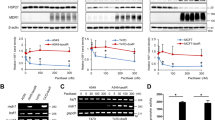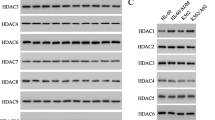Abstract
Overexpression of MDR1 in breast cancer remains a major cause for the failure of chemotherapy. In the present report, we find UHRF1 plays an important role in inhibiting MDR1 promoter activity by directly binding to the MDR1 promoter. Knockdown of UHRF1 activates MDR1 promoter activity and expression, attenuates the binding of UHRF1 and HDAC1 to the MDR1 promoter. Overexpression of UHRF1 in NCI/ADR-RES cells can induce deacetylation of histones H3 and H4 on the MDR1 promoter, which is facilitated by recruitment of HDAC1 to the MDR1 promoter. Loss of histone acetylation is accompanied by loss of binding of the key transcription factor, MyoD, CBP and p300, locking in marked suppression of MDR1, increasing sensitivity of MDR cancer cells to cytotoxic drugs that are transported by P-glycoprotein (P-gp). The inhibition of MDR1 expression by UHRF1 may provide potential ways to overcome multidrug resistance (MDR) in breast cancer treatment.







Similar content being viewed by others
Abbreviations
- MDR:
-
Multidrug resistance
- P-gp:
-
P-glycoprotein
- HAT:
-
Histone acetyltransferase
- HDAC1:
-
Histone deacetylase 1
- PBS:
-
Phosphate-buffered saline
- FBS:
-
Fetal bovine serum
References
Ling V (1987) Multidrug resistance and P-glycoprotein expression. Ann N Y Acad Sci 507:7–8
Roninson IB, Chin JE, Choi KG, Gros P, Housman DE, Fojo A, Shen DW, Gottesman MM, Pastan I (1986) Isolation of human mdr DNA sequences amplified in multidrug-resistant KB carcinoma cells. Proc Natl Acad Sci USA 83(12):4538–4542
Ling V, Thompson LH (1974) Reduced permeability in CHO cells as a mechanism of resistance to colchicine. J Cell Physiol 83(1):103–116
Fardel O, Lecureur V, Guillouzo A (1996) The PGP multidrug transporter. Gen Pharmacol 27(8):1283–1291
Sharom FJ (1997) The P-glycoprotein efflux pump: how does it transport drugs? J Membr Biol 160(3):161–175
Abolhoda A, Wilson AE, Ross H, Danenberg PV, Burt M, Scotto KW (1999) Rapid activation of MDR1 gene expression in human metastatic sarcoma after in vivo exposure to doxorubicin. Clin Cancer Res 5(11):3352–3356
Chaudhary PM, Roninson IB (1993) Induction of multidrug resistance in human cells by transient exposure to different chemotherapeutic drugs. J Natl Cancer Inst 85(8):632–639
Chin KV, Tanaka S, Darlington G, Pastan I, Gottesman MM (1990) Heat shock and arsenite increase expression of the multidrug resistance (MDR1) gene in human renal carcinoma cells. J Biol Chem 265(1):221–226
Hu Z, Jin S, Scotto KW (2000) Transcriptional activation of the MDR1 gene by UV irradiation. Role of NF-Y and Sp1. J Biol Chem 275(4):2979–2985
Uchiumi T, Kohno K, Tanimura H, Matsuo K, Sato S, Uchida Y, Kuwano M (1993) Enhanced expression of the human multidrug resistance 1 gene in response to UV light irradiation. Cell Growth Differ 4(3):147–157
Walther W, Stein U (1994) Influence of cytokines on mdr1 expression in human colon carcinoma cell lines: increased cytotoxicity of MDR relevant drugs. J Cancer Res Clin Oncol 120(8):471–478
Stein U, Walther W, Shoemaker RH (1996) Reversal of multidrug resistance by transduction of cytokine genes into human colon carcinoma cells. J Natl Cancer I 88(19):1383–1392
Stein U, Waltherm W, Shoemaker RH (1996) Modulation of mdr1 expression by cytokines in human colon carcinoma cells: an approach for reversal of MDR. Br J Cancer 74(9):1384–1391
Jin S, Scotto KW (1998) Transcriptional regulation of the MDR1 gene by histone acetyltransferase and deacetylase is mediated by NF-Y. Mol Cell Biol 18(7):4377–4384
Unoki M, Nishidate T, Nakamura Y (2004) ICBP90, an E2F-1 target, recruits HDAC1 and binds to methyl-CpG through its SRA domain. Oncogene 23(46):7601–7610
Bostick M, Kim JK, Estève PO, Clark A, Pradhan S, Jacobsen SE (2007) UHRF1 plays a role in maintaining DNA methylation in mammalian cells. Science 317(5845):1760–1764
Achour M, Jacq X, Rondé P, Alhosin M, Charlot C, Chataigneau T, Jeanblanc M, Macaluso M, Giordano A, Hughes AD, Schini-Kerth VB, Bronner C (2008) The interaction of the SRA domain of ICBP90 with a novel domain of DNMT1 is involved in the regulation of VEGF gene expression. Oncogene 27(15):2187–2197
Sharif J, Muto M, Takebayashi S, Suetake I, Iwamatsu A, Endo TA, Shinga J, Mizutani-Koseki Y, Toyoda T, Okamura K, Tajima S, Mitsuya K, Okano M, Koseki H (2007) The SRA protein Np95 mediates epigenetic inheritance by recruiting Dnmt1 to methylated DNA. Nature 450(7171):908–912
Hashimoto H, Horton JR, Zhang X, Cheng X (2009) UHRF1, a modular multi-domain protein, regulates replicationcoupled crosstalk between DNA methylation and histone modifications. Epigenetics 4(1):8–14
Kim JK, Estève PO, Jacobsen SE, Pradhan S (2009) UHRF1 binds G9a and participates in p21 transcriptional regulation in mammalian cells. Nucleic Acids Res 37(2):493–505
Hopfner R, Mousli M, Jeltsch JM, Voulgaris A, Lutz Y, Marin C, Bellocq JP, Oudet P, Bronner C (2000) ICBP90, a novel human CCAAT binding protein, involved in the regulation of topoisomerase IIa expression. Cancer Res 60(1):121–128
Bannister AJ, Kouzarides T (1996) The CBP co-activator is a histone acetyltransferase. Nature 384(6610):641–643
Ogryzko VV, Schiltz RL, Russanova V, Howard BH, Nakatani Y (1996) The transcriptional coactivators p300 and CBP are histone acetyltransferases. Cell 87(5):953–959
Blobel GA (2002) CBP and p300: versatile coregulators with important roles in hematopoietic gene expression. J Leukoc Biol 71(4):545–556
Vo N, Goodman RH (2001) CREB-binding Protein and p300 in transcriptional regulation. J Biol Chem 276(17):13505–13508
Hassig CA, Tong JK, Fleischer TC, Owa T, Grable PG, Ayer DE, Schreiber SL (1998) A role for histone deacetylase activity in HDAC1-mediated transcriptional repression. Proc Natl Acad Sci USA 95(7):3519–3524
Acknowledgments
This study was supported by the grants from the Innovation Program of Shanghai Municipal Education Commission (No. 09ZZ04); the Natural Science Foundation of Shanghai (No. 09ZR1406900); and Shanghai Pujiang Program and Scientific Research Foundation for the Returned Overseas Chinese Scholars, State Education Ministry.
Author information
Authors and Affiliations
Corresponding authors
Additional information
Wei Jin, Yang Liu and Si-guang Xu contributed equally to the present study.
Rights and permissions
About this article
Cite this article
Jin, W., Liu, Y., Xu, Sg. et al. UHRF1 inhibits MDR1 gene transcription and sensitizes breast cancer cells to anticancer drugs. Breast Cancer Res Treat 124, 39–48 (2010). https://doi.org/10.1007/s10549-009-0683-8
Received:
Accepted:
Published:
Issue Date:
DOI: https://doi.org/10.1007/s10549-009-0683-8




